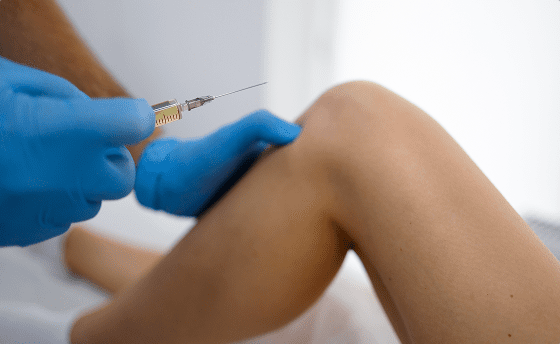KNEE

Knee Injections
A knee steroid injection is a medical procedure in which a corticosteroid medication is injected into the knee joint to reduce inflammation and provide relief from pain. This injection is often performed for conditions such as osteoarthritis, rheumatoid arthritis, bursitis, tendinitis, or other inflammatory joint conditions. The procedure can be done under imaging guidance, either ultrasound or fluoroscopy, to ensure precise placement of the medication.
Why is a Knee Steroid Injection Done?
Knee joint pain is a common issue, especially as people age, and it can be caused by a number of underlying conditions. Osteoarthritis, for instance, is a leading cause of knee pain and involves the breakdown of cartilage, leading to inflammation, pain, and stiffness. Conditions like rheumatoid arthritis, bursitis (inflammation of the bursa), and tendinitis (inflammation of tendons) can also lead to significant knee pain and swelling.
Steroid injections are commonly used as a treatment option for these conditions because they contain corticosteroids, powerful anti-inflammatory medications that can help to:
- Reduce Inflammation: Steroids help to reduce the inflammation that may be causing the pain and swelling in the knee joint.
- Relieve Pain: By decreasing inflammation, these injections often provide significant pain relief, allowing patients to return to their normal activities with improved mobility.
- Delay or Avoid Surgery: In many cases, steroid injections can help to manage symptoms effectively, delaying or even avoiding the need for more invasive treatments like knee surgery or joint replacement.
While steroid injections are not a permanent solution, they can provide significant relief and improve the quality of life for patients dealing with chronic knee pain.
How is a Knee Steroid Injection Done?
The procedure involves several key steps, and the choice of guidance method—either ultrasound or fluoroscopy—depends on the physician’s preference, the patient’s condition, and the equipment available.
1. Preparation
Before the injection, you will typically be asked to change into a gown and lie down on an examination table. The knee is usually positioned so that it is relaxed and accessible to the doctor performing the procedure. The skin over the knee joint will be cleaned with an antiseptic solution to reduce the risk of infection. You may also be given a local anesthetic to numb the area where the needle will be inserted, which helps minimize any discomfort during the injection.
2. Imaging Guidance: Ultrasound vs. Fluoroscopy
- Ultrasound-Guided Injection: In ultrasound-guided knee injections, the doctor uses high-frequency sound waves to visualize the internal structures of the knee joint in real-time. A small probe (similar to the one used in an ultrasound for pregnancy) is placed over the skin of the knee, and it sends sound waves into the joint. The reflected sound waves create an image on a monitor, allowing the doctor to see the exact location of the needle as it enters the joint. This enables precise placement of the steroid injection directly into the inflamed area.
Advantages of Ultrasound Guidance:
- Real-time imaging allows for very precise needle placement.
- It is a non-invasive, relatively low-cost option.
- It provides visual confirmation that the medication is being delivered to the correct area.
- Fluoroscopic (X-ray) Guidance: Fluoroscopy uses X-ray imaging to create real-time video images of the knee joint. In this technique, the doctor can observe the needle’s movement on a monitor as it is guided into the joint. Fluoroscopy is particularly useful in deeper or more complex joint injections where direct visualization is critical to avoid damage to surrounding tissues.
Advantages of Fluoroscopy Guidance:
- It provides clear, detailed images of the knee’s anatomy.
- It is especially helpful for accurately injecting medication into specific areas like the knee’s inner compartments or deep structures.
- It allows for continuous monitoring of needle placement throughout the procedure.
3. The Injection
Once the needle is in the correct position, the corticosteroid solution is slowly injected into the joint. The steroid typically comes mixed with a local anesthetic, which provides immediate pain relief while the steroid works to reduce inflammation. The entire procedure usually takes no more than 3-5 minutes.
4. Post-Injection Care
After the injection, you will be observed for a short period to ensure that there are no immediate reactions to the steroid or anesthesia. The knee may feel slightly sore after the procedure, especially if the area was inflamed. You may also experience a temporary increase in pain or swelling, which is generally short-lived.
In some cases, you may be instructed to rest for a day or two, avoid heavy exercise or strenuous activity, and apply ice to the area to help reduce any discomfort or swelling. You should be able to resume most of your regular activities soon after, but it’s important to follow your doctor’s recommendations.
Benefits of Knee Steroid Injections
- Pain Relief: The primary benefit of a knee steroid injection is pain relief. Most patients experience a significant reduction in pain within a few days to a week after the injection.
- Improved Mobility: Reducing pain and inflammation can help improve your ability to move the knee more freely, which is important for daily activities like walking, climbing stairs, and exercising.
- Cost-Effective: Compared to other treatments like surgery or joint replacement, steroid injections are relatively low-cost and less invasive.
- Quick Recovery: Because the procedure is minimally invasive, the recovery time is generally short, and most people can resume normal activities fairly quickly.
While knee steroid injections are generally safe, there are some potential risks and side effects:
When Should You Consider a Knee Steroid Injection?
Knee steroid injections are often recommended when conservative treatments, such as physical therapy, oral medications (like nonsteroidal anti-inflammatory drugs), or lifestyle changes (such as weight loss and exercise), have not provided sufficient relief. They are also used when the pain is significantly affecting the patient’s quality of life or preventing them from performing essential daily activities.
In summary, a knee steroid injection performed under ultrasound or fluoroscopic guidance is a highly effective procedure for relieving pain and inflammation in the knee joint. It provides a non-invasive, low-risk alternative to surgery and can offer significant improvements in mobility and comfort for patients with chronic knee pain. However, like any medical procedure, it is important to discuss the potential benefits and risks with your healthcare provider to determine if this treatment is appropriate for your specific condition.
